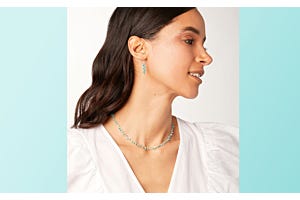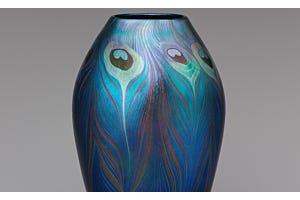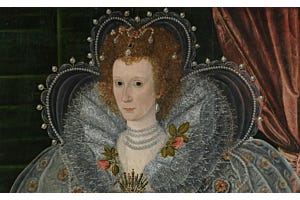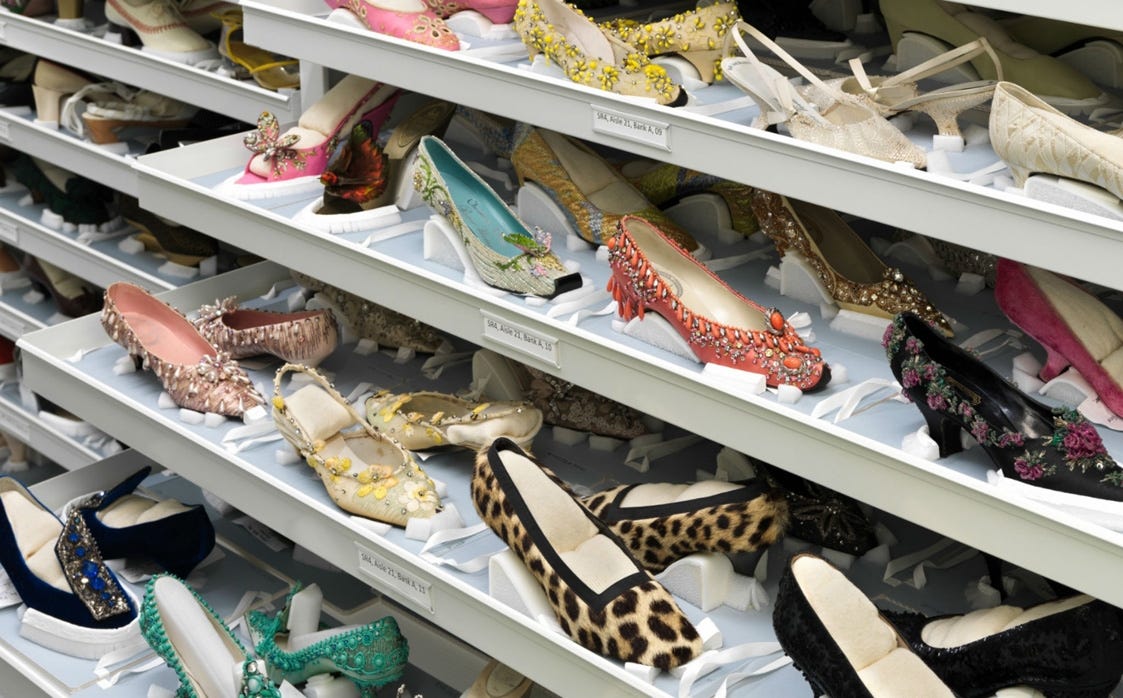
We're already thinking about trimming our trees with this year's batch of annual shoe ornaments and bag ornaments. With accessories on our mind, we caught up with Associate Curator Jessica Regan of The Met's The Costume Institute to ask how shoes and bags fit into The Met collection—and why they're so irresistible to fashion fans.

Have shoes and bags always been represented in The Costume Institute collection? How many shoes and handbags are currently in the collection?
Yes, accessories have been part of The Costume Institute’s collection since it was established, in 1937. It was known then as the Museum of Costume Art, and was a separate institution from The Met. Although The Costume Institute didn’t become part of The Met until 1946, the Museum was actually collecting some fashion, including accessories, before that time. In those early years, there was an emphasis on collecting historical examples, primarily 18th- and 19th-century. By the 1950s and 1960s there was an increasing interest in collecting contemporary accessories, and we’ve continued to collect shoes, handbags, and other accessories across a broad range of periods. We now have over 3,000 shoes and over 1,000 bags in our collection.
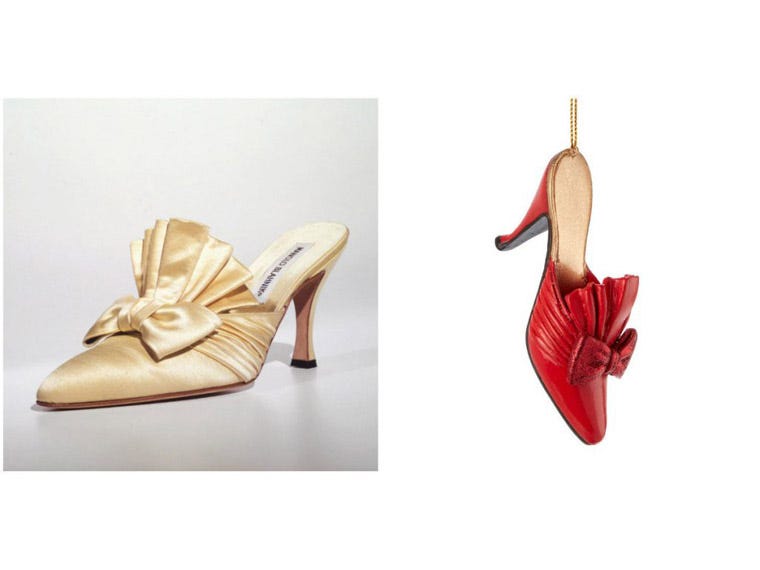
Left: Evening mules, 1990–92. Manolo Blahnik (British, born Spain, 1942). Silk. Brooklyn Museum Costume Collection at The Metropolitan Museum of Art, Gift of the Brooklyn Museum, 2009; Gift of Manolo Blahnik, 1992 (2009.300.6065a, b). Right: Red Evening Shoe Ornament, $28
Tell us about The CI’s current collecting strategy.
Since our founding years, The Costume Institute has been dedicated to establishing one of the most comprehensive costume collections in the world. As a result, the collection today represents a timeline of Western high fashion from the 18th century to the present. In recent years, though, the department’s mission has shifted from building an encyclopedic collection to acquiring masterworks―examples that we consider to be of the highest aesthetic and technical quality, and that serve as outstanding expressions of their eras. Our collecting criteria are a bit different depending on the period, but in general we’re looking for pieces that are exhibition-worthy, meaning that they’re in a good state of preservation, without any significant alterations.
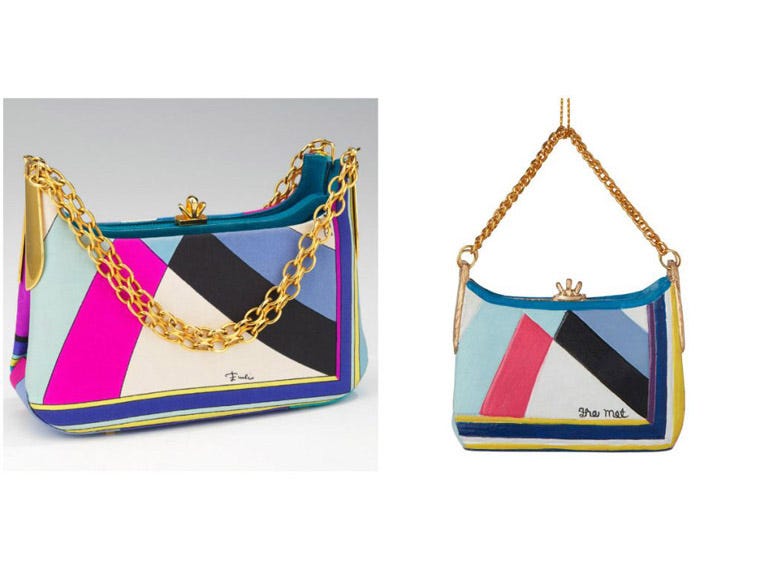
Left: Cocktail bag, 1965–70. Emilio Pucci (Italian, 1914–1992). Silk, metal, leather. Brooklyn Museum Costume Collection at The Metropolitan Museum of Art, Gift of the Brooklyn Museum, 2009; Gift of Ada Friedberg, 1991 (2009.300.2646). Right: Cocktail Bag Ornament, $28
How can accessories express a designer’s vision?
I think accessories can have a particular immediacy in conveying a designer’s vision. They’re designed to punctuate an ensemble, to make an impact on a relatively small physical scale, so they’re often a distillation of a designer’s concept―the purest expression of an idea. For the wearer, accessories can be used to coordinate discreetly with an ensemble, or to attract attention. They have the potential to completely transform the wearer, and so they’re an area for risk-taking, and an opportunity for designers to put forward their boldest visions.
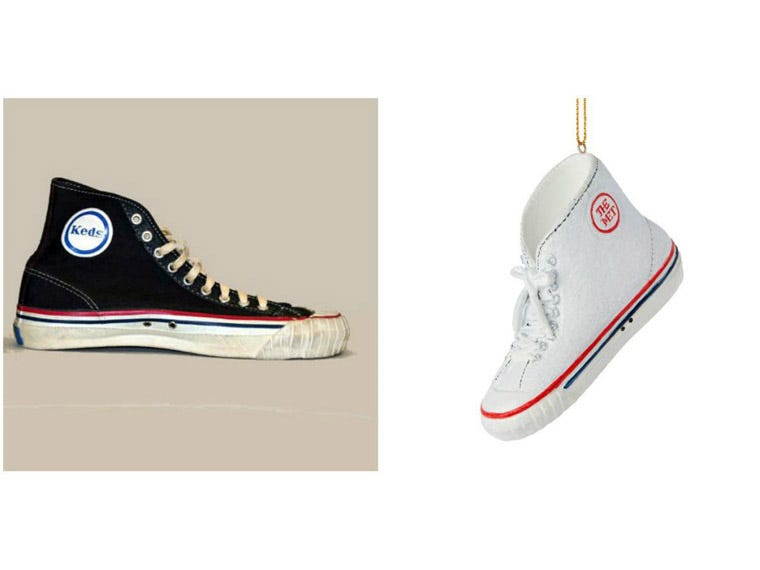
Left: Sneakers, 1972. American. Gift of Sills and Company, 1972 (1972.162.2a, b). Right: High-Top Sneaker Shoe Ornament, $28
What can shoes and handbags tell us about the period in which they were made?
Like other items of fashion, they can reveal the social history of an era, the innovations of their makers, and the priorities of a period. Eighteenth-century European and American shoes, for example, reflect the emphasis placed on fine textiles and surface embellishments, which were the most important elements of high-style apparel for both men and women. The rich fabrics of the period, woven on hand-operated looms, represent a significant investment of time, materials, and skilled labor. So, shoes from this period that are made from silks woven or embroidered in complex patterns reveal the artistry of an interconnected network of artisans―textile designers, weavers, and embroiderers.
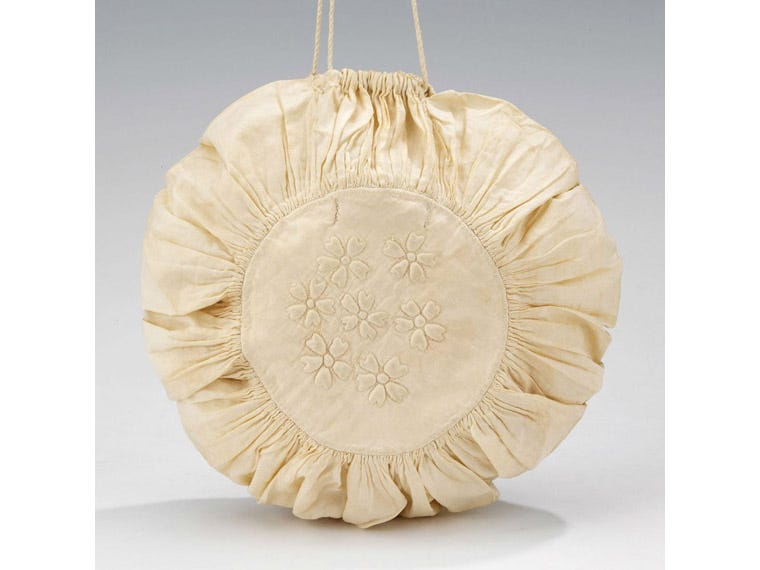
Reticule, first quarter 19th century. American. Cotton. Brooklyn Museum Costume Collection at The Metropolitan Museum of Art, Gift of the Brooklyn Museum, 2009; Gift of Mrs. James H. Post, 1952 (2009.300.2382)
Accessories can also reflect broader changes in fashion. In the early 19th century there was a fad in Europe and America for small mesh bags known as reticules. These became popular as women’s fashion shifted from voluminous gowns made of heavy, brocaded silks, to slim, columnar dresses made of fine cotton. Under expansive 18th-century gowns, women wore separate pockets that tied around the waist, which were accessible through slits in the side seams of the skirt. Once women were wearing narrower skirts of lightweight materials that wouldn’t hide a roomy pocket underneath, they began to carry small, handheld bags. These bags had particular fashionable appeal since they could be made in a range of shapes and sizes, and with a variety of embellishments.
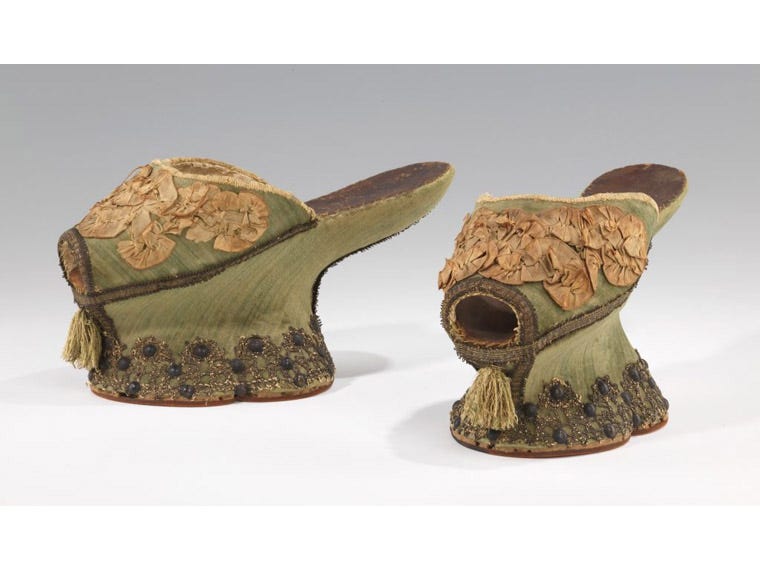
Chopines, 1550–1650. Italian. Silk, metal. Brooklyn Museum Costume Collection at The Metropolitan Museum of Art, Gift of the Brooklyn Museum, 2009; Gift of Herman Delman, 1955 (2009.300.1494a, b)
What does a platform pump convey? A slingback? A mule?
The predecessor of the modern platform shoe is the chopine of the Renaissance era, a tall clog that was worn primarily in Venice. Ostensibly, their purpose was to elevate the wearer and her skirts from damp and dirty streets—but, equally, these shoes increased her physical prominence, and were a signal of (literally) elevated status. Most surviving examples are between three and five inches tall, though some are over a foot tall. These more extreme examples have continued to inspire generations of modern designers, including Salvatore Ferragamo, Vivienne Westwood, and Noritaka Tatehana, all of whom are represented in The Costume Institute’s collection. The Westwood shoes that were the inspiration for one of the ornaments you’re offering are a great example of her frequent referencing of historical styles. Over the course of her career, she has explored platforms in a variety of forms, favoring extreme heights that have the effect of amplifying the provocative impact of her clothing.
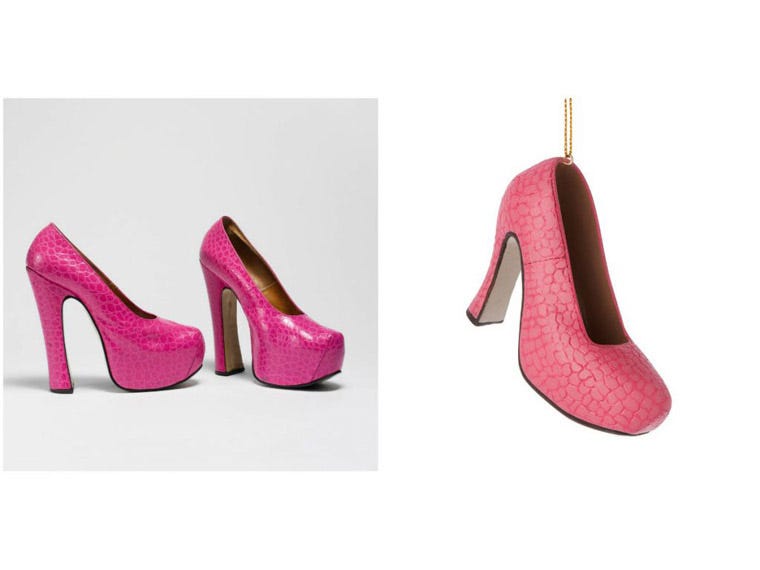
Left: Shoes, 1990. Vivienne Westwood (British, born 1941). Leather. Millia Davenport and Zipporah Fleisher Fund, 2006 (2006.14a, b). Right: Platform Pump Shoe Ornament, $28
Shoes that are open at the back with a strap that encircles the back of the heel became fashionable in the 1930s. The style allowed more of the foot to be exposed, but was still easy to slip on. The pair by Roger Vivier that inspired one of your ornaments is a wonderful example of his designs for the House of Dior. There was a great synergy between the two designers, who both had an architectural approach to fashion. Dior created dramatic silhouettes that were frequently enhanced with striking beading and embroidery. Vivier took a complementary approach, creating shoes of innovative, carefully sculpted shapes that became vehicles for intricate embellishments. In 1963, after designing for Dior for a decade, Vivier opened a shoe salon under his own name, and continued to create some of the most distinctive shoe shapes in 20th-century fashion.
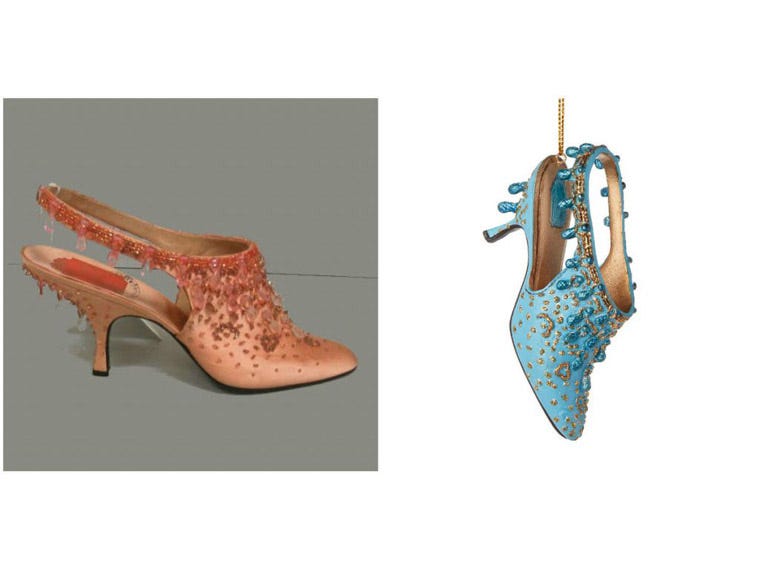
Left: Evening shoes, 1954. Roger Vivier (French, 1913–1998) for House of Dior (French, founded 1947). Silk, glass. Gift of Valerian Stux-Rybar, 1980 (1980.597.15). Right: Embellished Blue Shoe Ornament, $28
Do you have a favorite shoe or handbag in the collection?
We have a pair of American shoes from about 1775 that are part of an ensemble that includes a dress in a matching silk. Both the shoes and gown are made of a deep green silk damask from the 1740s. Throughout the 18th century it was typical to reuse textiles in this way, since they were such an investment. It’s really unusual, though, for both dress and shoes to survive together, so these shoes are a rare example that give us a better understanding of an 18th-century American woman’s wardrobe.
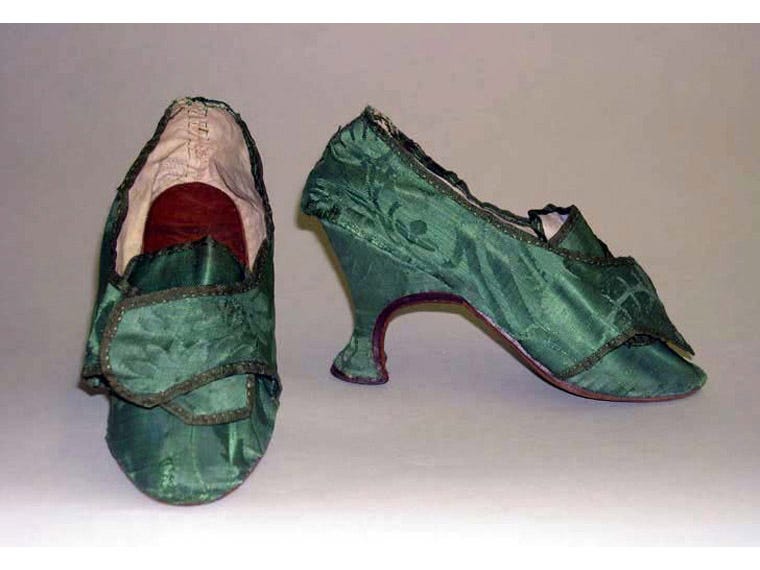
Shoes from ensemble, ca. 1775. American. Silk. Purchase, Irene Lewisohn Trust Gift, 1994 (1994.406a–c)
What makes shoes so irresistible to fashion lovers?
I think shoes are items that allow the wearer’s personality to come through, even if their personal style is otherwise subdued. Shoes, and other accessories, can be an opportunity to be a bit more adventurous.
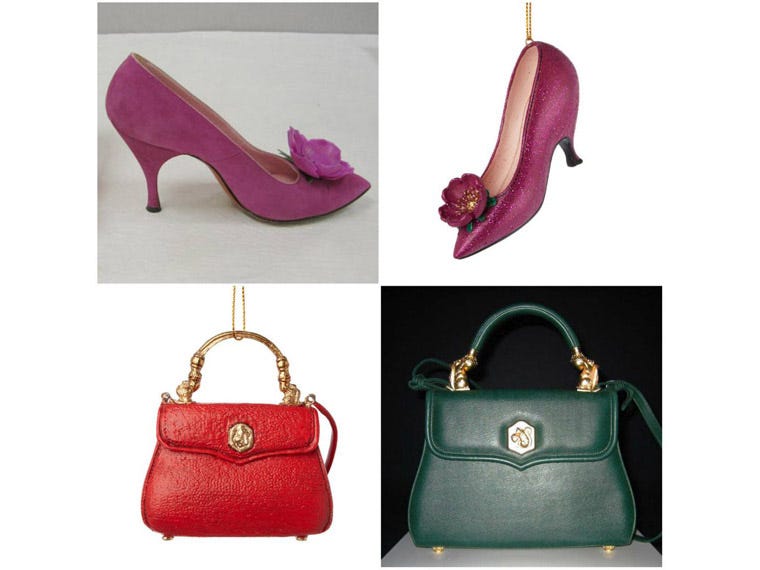
Clockwise from top left: Pumps, 1959; Beth Levine (American, 1914–2006) for Herbert Levine Inc. (American, founded 1949); leather, synthetic; Gift of Helene Verin, 2009 (2009.328a, b). Purple Poppy Shoe Ornament, $28. Purse, 1994, Barry Kieselstein-Cord (American, born 1948); gold, leather, silk; Gift of Barry Kieselstein-Cord, 1995 (1995.380.6a, b). Red Purse Ornament, $28

